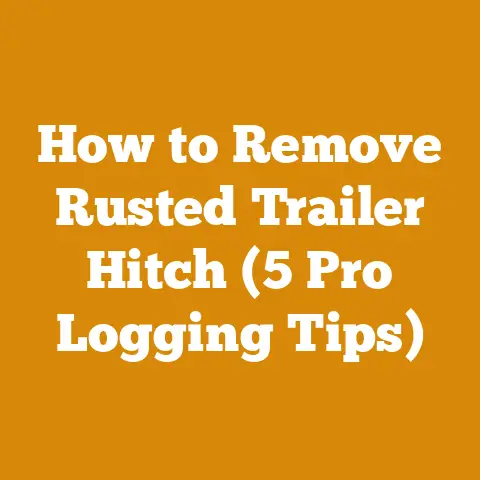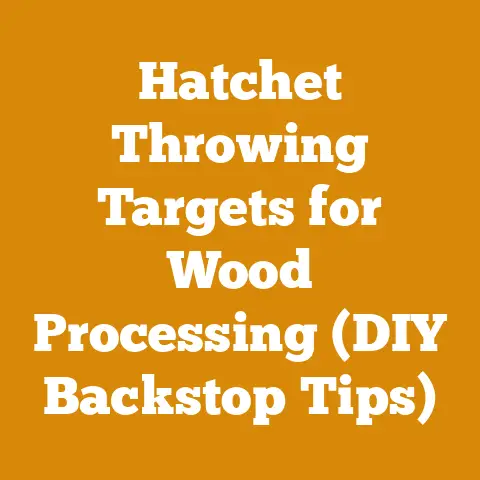Kimball Penetrating Oil Benefits (5 Proven Hacks for Woodworkers)
Here’s an opportunity: Imagine being able to salvage antique woodworking tools, revive neglected garden implements, or simply free a stubborn bolt without resorting to brute force.
Kimball Penetrating Oil, often overlooked, can be your secret weapon.
It’s not just another lubricant; it’s a problem-solver.
In this guide, I’ll share my experiences and five proven hacks for woodworkers and anyone who appreciates the value of a well-maintained tool.
Kimball Penetrating Oil Benefits: 5 Proven Hacks for Woodworkers
I’ve spent years working with wood, from felling trees to crafting intricate furniture.
Along the way, I’ve learned the importance of maintaining my tools.
Rust, corrosion, and seized parts can quickly turn a rewarding project into a frustrating ordeal.
That’s where a good penetrating oil comes in.
Kimball Penetrating Oil, in my experience, stands out for its ability to creep into tight spaces and dissolve rust, making it an invaluable asset in the workshop.
What is Kimball Penetrating Oil?
Kimball Penetrating Oil is a specially formulated lubricant designed to loosen rusted or corroded parts.
Unlike regular oils, it has a low viscosity, allowing it to seep into tiny crevices.
Its unique blend of solvents and lubricants works to dissolve rust and break down the bonds between stuck components.
Why Choose Kimball Penetrating Oil?
I’ve tried many penetrating oils over the years, and Kimball consistently delivers.
Here’s why I prefer it:
- Superior Penetration: Its thin consistency allows it to reach even the most inaccessible areas.
- Effective Rust Removal: It dissolves rust quickly and effectively, minimizing the need for excessive force.
- Protection Against Corrosion: It leaves a protective layer that helps prevent future corrosion.
- Safe for Most Materials: It’s generally safe to use on metal, plastic, and rubber (always test on an inconspicuous area first).
- Versatile Applications: From freeing rusted bolts to lubricating delicate mechanisms, it’s a true multi-purpose product.
Takeaway: Kimball Penetrating Oil is a versatile and effective solution for loosening rusted parts and preventing corrosion.
Hack #1: Reviving Antique Woodworking Tools
One of my passions is restoring antique woodworking tools.
These tools often represent a bygone era of craftsmanship, but they also tend to be heavily rusted and seized.
The Challenge
Antique tools can be incredibly delicate.
Applying too much force can damage or break irreplaceable parts.
Traditional methods like hammering or heating can be risky.
My Experience
I once acquired a beautiful old hand plane from an estate sale.
The blade adjustment mechanism was completely frozen.
I was hesitant to force it, fearing I would damage the delicate threads.
The Solution
- Initial Cleaning: I started by gently cleaning the plane with a soft brush and mineral spirits to remove loose dirt and debris.
- Application: I liberally applied Kimball Penetrating Oil to the blade adjustment mechanism, making sure to saturate all the threads.
- Soaking Time: I let the oil soak for 24 hours, reapplying it periodically to keep the area saturated.
- Gentle Pressure: After 24 hours, I gently tried to turn the adjustment knob.
It was still stiff, but I could feel it starting to loosen. - Repeat Application: I reapplied the oil and let it soak for another 12 hours.
- Success! This time, the knob turned freely.
I continued to work the mechanism back and forth, adding more oil as needed, until it moved smoothly.
The Results
The Kimball Penetrating Oil had worked its magic.
The blade adjustment mechanism was now fully functional, and I was able to restore the plane to its former glory.
Tips for Success
- Patience is Key: Don’t rush the process.
Allow the oil plenty of time to penetrate. - Reapply Regularly: Keep the area saturated with oil for optimal results.
- Use Gentle Pressure: Avoid using excessive force, which can damage delicate parts.
- Consider Heat (Carefully): If the parts are extremely stubborn, you can try applying gentle heat with a heat gun or hairdryer.
Be careful not to overheat the metal, as this can damage the temper. - Proper Lubrication: Once the parts are free, clean them thoroughly and apply a high-quality lubricant to prevent future corrosion.
Takeaway: Kimball Penetrating Oil is a safe and effective way to revive antique woodworking tools without damaging delicate parts.
Patience and persistence are essential.
Hack #2: Freeing Rusted Screws and Bolts
Rusted screws and bolts are a common problem in woodworking, especially when working with reclaimed lumber or outdoor projects.
The Challenge
Trying to remove a rusted screw or bolt can easily lead to stripping the head or breaking the fastener.
This can make the problem even worse.
My Experience
I was building a deck using reclaimed lumber, and many of the screws were heavily rusted.
I tried using a screwdriver, but the heads quickly started to strip.
The Solution
- Preparation: I cleaned the area around the screw heads with a wire brush to remove loose rust and debris.
- Application: I applied Kimball Penetrating Oil directly to the screw heads, making sure to saturate the threads.
- Soaking Time: I let the oil soak for at least 30 minutes, or longer if the screws were heavily rusted.
- Impact Driver: I used an impact driver with the correct bit size to apply controlled bursts of torque.
The impact action helps to break the rust bonds. - Gentle Pressure: I applied firm, steady pressure while using the impact driver.
- Success! Most of the screws came out without stripping or breaking.
The Results
I was able to remove the rusted screws quickly and easily, without damaging the surrounding wood.
This saved me a lot of time and frustration.
Tips for Success
- Use the Right Bit: Make sure you’re using the correct bit size for the screw head.
A loose-fitting bit is more likely to strip the head. - Apply Firm Pressure: Apply firm, steady pressure while turning the screw or bolt.
- Impact Driver is Key: An impact driver is much more effective than a regular screwdriver for removing rusted fasteners.
- Heat (Optional): If the screws are extremely stubborn, you can try applying gentle heat to the screw head before applying the penetrating oil.
- Screw Extractors: If you do strip the head of a screw, you can use a screw extractor to remove it.
Takeaway: Kimball Penetrating Oil, combined with an impact driver, is a powerful solution for removing rusted screws and bolts without damaging the surrounding wood.
Hack #3: Lubricating Hand Plane Soles
A smooth hand plane sole is essential for achieving a flawless finish.
Over time, the sole can become sticky or develop a slight layer of rust, hindering its performance.
The Challenge
A sticky or rusty hand plane sole can cause the plane to skip or chatter, resulting in an uneven surface.
My Experience
I noticed that my favorite hand plane was starting to stick as I planed a piece of hardwood.
The sole felt rough to the touch.
The Solution
- Cleaning: I thoroughly cleaned the sole of the plane with a clean cloth and mineral spirits to remove any dirt, wax, or old oil.
- Application: I lightly sprayed Kimball Penetrating Oil onto a clean cloth.
- Wiping: I wiped the sole of the plane with the oiled cloth, making sure to apply a thin, even coating.
- Buffing: I buffed the sole with a clean, dry cloth to remove any excess oil.
The Results
The sole of the plane was now smooth and slick.
The plane glided effortlessly across the wood, producing a flawless finish.
Tips for Success
- Use Sparingly: A little penetrating oil goes a long way.
Avoid applying too much, as this can attract dust and debris. - Buff Thoroughly: Make sure to buff the sole thoroughly to remove any excess oil.
- Regular Maintenance: Repeat this process regularly to keep the sole of your hand plane in top condition.
- Alternative Lubricants: You can also use paste wax or paraffin wax to lubricate the sole of your hand plane.
Takeaway: A thin coating of Kimball Penetrating Oil can significantly improve the performance of your hand plane by reducing friction and preventing rust.
Hack #4: Protecting Tools from Rust
Preventing rust is always better than trying to remove it.
Kimball Penetrating Oil can be used as a protective coating to prevent rust from forming on your tools.
The Challenge
Tools stored in humid environments are particularly susceptible to rust.
Rust can quickly damage tools, making them difficult to use and reducing their lifespan.
My Experience
I live in a humid climate, and I’ve learned the hard way that rust can quickly take hold if tools aren’t properly protected.
The Solution
- Cleaning: I thoroughly clean my tools with a clean cloth and mineral spirits to remove any dirt, grease, or fingerprints.
- Application: I lightly spray Kimball Penetrating Oil onto a clean cloth.
- Wiping: I wipe all metal surfaces of the tools with the oiled cloth, making sure to apply a thin, even coating.
- Storage: I store the tools in a dry environment, such as a tool chest or cabinet.
The Results
The tools are protected from rust and corrosion, even in humid conditions.
This helps to prolong their lifespan and keep them in top condition.
Tips for Success
- Apply Regularly: Reapply the penetrating oil every few months, or more often if the tools are exposed to humid conditions.
- Focus on Metal Surfaces: Pay particular attention to metal surfaces that are prone to rust, such as blades, edges, and joints.
- Consider Desiccants: In extremely humid environments, you can also use desiccants to absorb moisture and further protect your tools.
- Proper Ventilation: Ensure adequate ventilation in your workshop or storage area to reduce humidity levels.
Takeaway: A thin coating of Kimball Penetrating Oil can effectively protect your tools from rust and corrosion, prolonging their lifespan and keeping them in top condition.
Hack #5: Loosening Stuck Machinery Parts
From lawnmowers to garden tractors, outdoor machinery often suffers from seized or stuck parts due to rust and corrosion.
The Challenge
Trying to force stuck machinery parts can damage or break them, leading to costly repairs.
My Experience
The blade engagement lever on my lawnmower was completely frozen.
I couldn’t engage the blades, and the lawnmower was unusable.
The Solution
- Identification: I identified the areas where the lever was sticking.
- Cleaning: I cleaned the area around the lever with a wire brush to remove loose rust and debris.
- Application: I liberally applied Kimball Penetrating Oil to the pivot points and joints of the lever mechanism.
- Soaking Time: I let the oil soak for at least 24 hours, reapplying it periodically to keep the area saturated.
- Gentle Movement: After 24 hours, I gently tried to move the lever back and forth.
It was still stiff, but I could feel it starting to loosen. - Repeat Application: I reapplied the oil and let it soak for another 12 hours.
- Success! This time, the lever moved freely.
I continued to work the mechanism back and forth, adding more oil as needed, until it moved smoothly.
The Results
The blade engagement lever was now fully functional, and I was able to use my lawnmower again.
Tips for Success
- Identify the Sticking Points: Carefully examine the mechanism to identify the areas where it’s sticking.
- Apply Liberally: Don’t be afraid to use plenty of penetrating oil.
- Work the Mechanism: Once the parts start to loosen, continue to work the mechanism back and forth to help the oil penetrate further.
- Grease After Loosening: After the parts are free, clean them thoroughly and apply a high-quality grease to prevent future corrosion.
Takeaway: Kimball Penetrating Oil can effectively loosen stuck machinery parts, saving you time and money on repairs.
Patience and persistence are essential.
Safety Precautions When Using Penetrating Oil
While Kimball Penetrating Oil is a valuable tool, it’s important to use it safely.
- Ventilation: Use penetrating oil in a well-ventilated area.
The fumes can be irritating to the respiratory system. - Eye Protection: Wear safety glasses to protect your eyes from splashes.
- Skin Protection: Wear gloves to protect your skin from prolonged exposure.
- Flammability: Penetrating oil is flammable. Keep it away from open flames and sparks.
- Disposal: Dispose of used oil and rags properly, according to local regulations.
- Read the Label: Always read and follow the manufacturer’s instructions on the product label.
Takeaway: Always prioritize safety when using penetrating oil.
Use proper ventilation, wear protective gear, and follow the manufacturer’s instructions.
Conclusion
Kimball Penetrating Oil is more than just a lubricant; it’s a versatile problem-solver that can save you time, money, and frustration in the workshop and beyond.
From reviving antique tools to freeing rusted machinery parts, its ability to penetrate and dissolve rust makes it an indispensable asset.
By following the proven hacks outlined in this guide, you can harness the power of Kimball Penetrating Oil and keep your tools and equipment in top condition for years to come.
Remember to always prioritize safety and use the product responsibly.
Now, go forth and conquer those rusted challenges!






